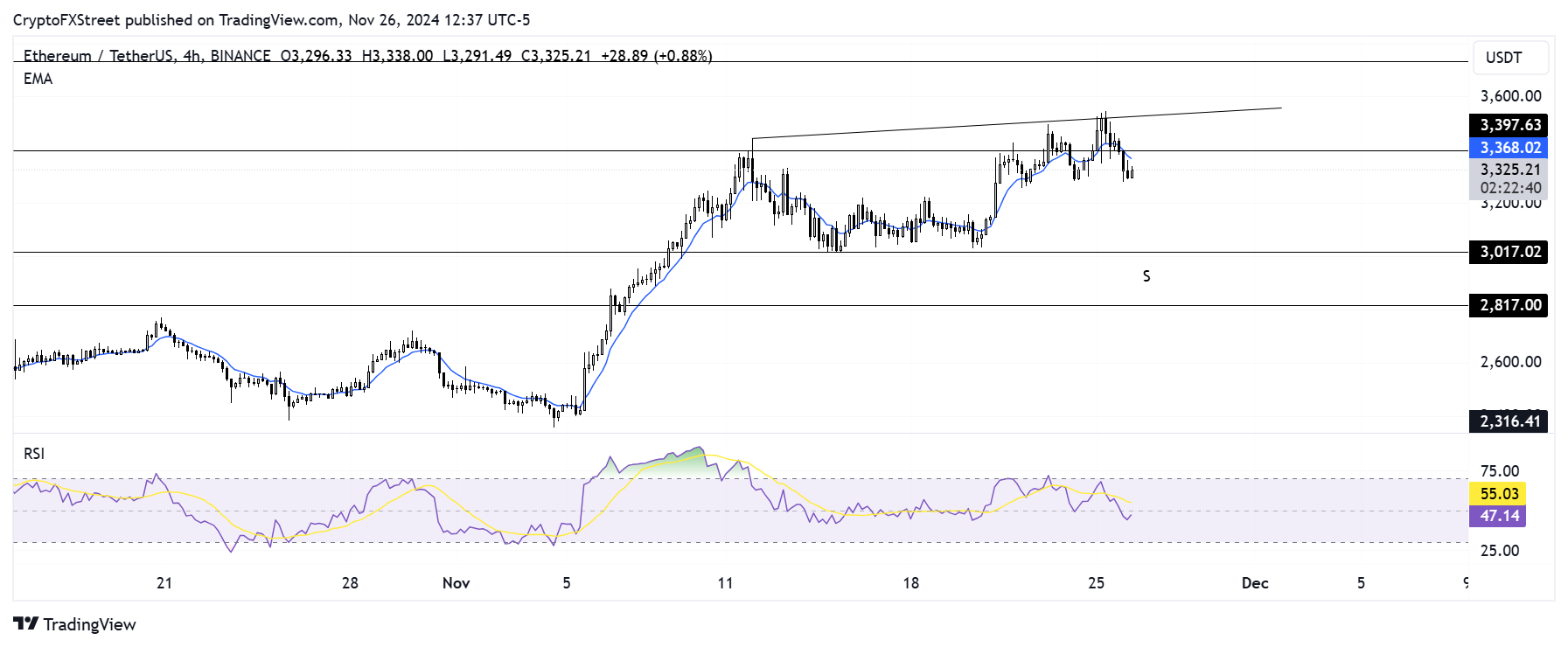Ethereum Forecast: ETH on-chain data shows mixed investor sentiment amid price decline
Ethereum price today: $3,360
- Ethereum exchange reserve and options data indicate bearish bias among traders.
- However, ETH's increased open interest and spot exchange net outflows show investors are still bullish.
- Ethereum could fall to $2,300 if it validates a triple top pattern by declining below the $3,000 psychological level.
Ethereum (ETH) is down 3% on Tuesday and could decline to $2,300 if the $3,000 support level fails. The recent decline follows mixed investor sentiment across the top altcoin's on-chain metrics.
ETH on-chain activity indicates mixed investor sentiment
Ethereum exchange reserves began trending upwards on Tuesday after seven days of seeing downward pressure, per CryptoQuant data. The rising exchange reserve suggests ETH saw selling activity, particularly after reaching a four-month high of $3,547 on Monday.
-638682417021037279.png)
ETH Exchange Reserve
Options traders are also gradually flipping bearish as ETH implied volatility "has shifted sharply toward puts over calls," noted QCP analysts. "Growing concerns about downside risks may intensify, particularly with tonight's FOMC minutes and Wednesday's PCE data on the horizon."
However, on the futures front, Ethereum is showing a bullish picture after it's open interest (OI) surged to a new all-time high of $21.22 billion in the Asian session on Tuesday, per Coinglass data.
Open interest is the total number of outstanding contracts in a derivatives market. An uptick in OI signifies new money is coming into the market.
A similar bullish trend is evident in the spot market as the top altcoin has recorded high net outflows across leading crypto exchanges like Binance, OKX, Coinbase, Kraken and Bybit in the past 24 hours, per Coinglass data. Net outflows in the spot market suggest buying activity among investors.

ETH Spot Exchange Netflows
Meanwhile, Ethereum ETFs recorded net inflows of $2.9 million on Monday.
Ethereum Price Forecast: ETH could decline to $2,300 if it validates triple top pattern
Ethereum is down 3% on Tuesday following $76.23 million in ETH futures liquidations in the past 24 hours. Liquidated long and short positions accounted for $64.48 million and $11.75 million, respectively.
ETH appears to have posted a triple top pattern after seeing a rejection near an ascending trendline and declining below the $3,400 key level.

ETH/USDT 4-hour chart
If ETH validates the pattern by declining below the $3,000 support level, it could find support near the $2,817 key level, which buyers have defended for nearly four months — April through July.
A decline below the $2,817 level will send ETH to find support near the $2,300 level, a historically high demand zone.
The Relative Strength Index (RSI) is declining and testing its neutral level midline, indicating rising bearish momentum.
A candlestick close above the ascending trendline will invalidate the thesis.
Ethereum FAQs
Ethereum is a decentralized open-source blockchain with smart contracts functionality. Its native currency Ether (ETH), is the second-largest cryptocurrency and number one altcoin by market capitalization. The Ethereum network is tailored for building crypto solutions like decentralized finance (DeFi), GameFi, non-fungible tokens (NFTs), decentralized autonomous organizations (DAOs), etc.
Ethereum is a public decentralized blockchain technology, where developers can build and deploy applications that function without the need for a central authority. To make this easier, the network leverages the Solidity programming language and Ethereum virtual machine which helps developers create and launch applications with smart contract functionality.
Smart contracts are publicly verifiable codes that automates agreements between two or more parties. Basically, these codes self-execute encoded actions when predetermined conditions are met.
Staking is a process of earning yield on your idle crypto assets by locking them in a crypto protocol for a specified duration as a means of contributing to its security. Ethereum transitioned from a Proof-of-Work (PoW) to a Proof-of-Stake (PoS) consensus mechanism on September 15, 2022, in an event christened “The Merge.” The Merge was a key part of Ethereum's roadmap to achieve high-level scalability, decentralization and security while remaining sustainable. Unlike PoW, which requires the use of expensive hardware, PoS reduces the barrier of entry for validators by leveraging the use of crypto tokens as the core foundation of its consensus process.
Gas is the unit for measuring transaction fees that users pay for conducting transactions on Ethereum. During periods of network congestion, gas can be extremely high, causing validators to prioritize transactions based on their fees.

